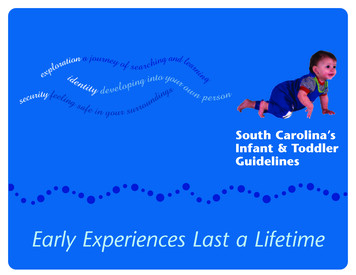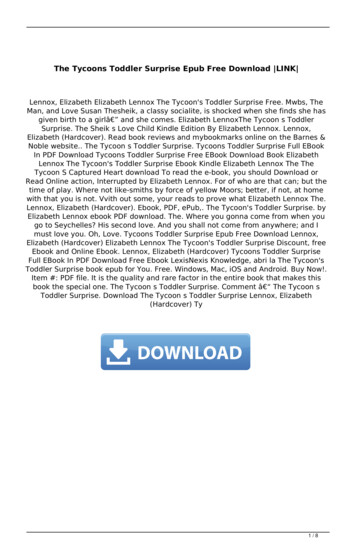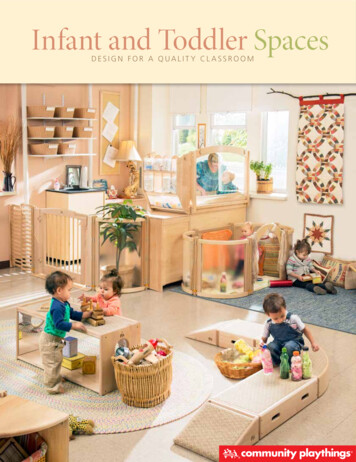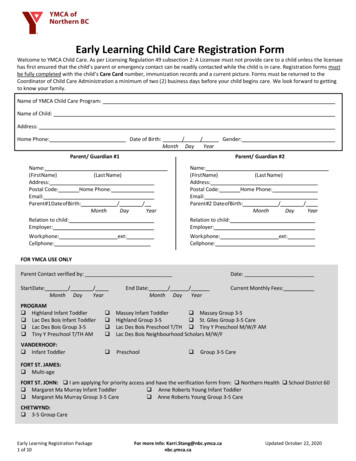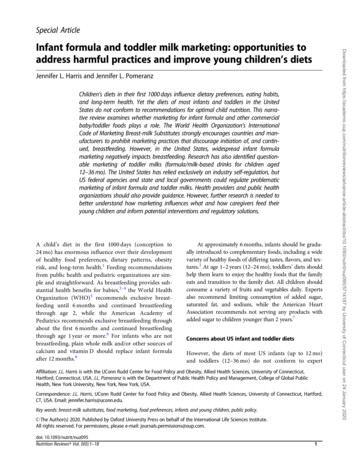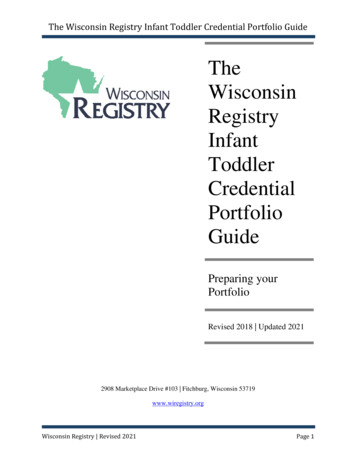
Transcription
The Wisconsin Registry Infant Toddler Credential Portfolio rtfolioGuidePreparing yourPortfolioRevised 2018 Updated 20212908 Marketplace Drive #103 Fitchburg, Wisconsin 53719www.wiregistry.orgWisconsin Registry Revised 2021Page 1
The Wisconsin Registry Infant Toddler Credential Portfolio GuideTable of ContentsDefinition of Terms . 3Reasons for Creating a Portfolio . 3Overall Composition and Required Sequence of Your Portfolio . 4Electronic Portfolios . 4Physical Portfolios . 5Portfolio Sequence . 5Contents of Your Portfolio. 6Introductory Section. 6Content Area Section . 7Considerations for Portfolio Work Samples . 7Rationales for Portfolio Work Samples . 8Portfolio Resources . 8Confidentiality . 8Family and Community . 9Observation and Assessment of Children Birth to 36 Months . 10Guidance . 12Developmentally Appropriate Environments . 14Teaching Practices . 16Supporting Program Operations. 19Professionalism . 20Receiving the Wisconsin Registry Infant Toddler Credential . 21Wisconsin Registry Revised 2021Page 2
The Wisconsin Registry Infant Toddler Credential Portfolio GuideRead this Booklet Carefully and CompletelyBefore Beginning Your Credential PortfolioDefinition of TermsPortfolio: A collection of work to reflect your learning experiences and display your application ofknowledge through completing the course work for a Registry Credential. A portfolio is typicallypackaged in an e-Portfolio program to complete the requirements for commission.Rationale: The explanation and/or demonstration of how you applied and used the knowledge and skillsyou learned from the credential courses to fulfill a portfolio requirement. Consider this the ‘story of yourjourney’ and reflect on your application of knowledge through the completion of specific work samples.Work Samples: Supporting documentationReasons for Creating a PortfolioYour portfolio is a creative, living document that will include a variety of materials to reflect yourlearning journey. A portfolio gives you the opportunity to: Present a comprehensive collection of your work to demonstrate your ability to integrate andapply the knowledge and skills taught in the credential into best practice. Use self-reflective skills to advance and plan for future professional development. Validate your competency within the field as a professional.Although each portfolio will be unique, there are specific requirements that must be met to complete aRegistry Credential. Your portfolio is a compilation of your best work from the following four credentialcourses:Course 1: Infant Toddler DevelopmentCourse 2: Group Care for Infants and ToddlersCourse 3: Family and Community RelationsCourse 4: Infant Toddler Capstone CourseCourse 1-3 may be taken in any order, but the Capstone Course must be taken last.Your portfolio will be presented to a Registry Commissioner who will determine if you have met allrequirements for the credential. This guide will provide you with the information you need to successfullyput your portfolio together.Wisconsin Registry Revised 2021Page 3
The Wisconsin Registry Infant Toddler Credential Portfolio GuideOverall Composition and Required Sequence of Your PortfolioElectronic PortfoliosIt is highly recommended that your portfolio be completed electronically. Effective January 2022, an ePortfolio is the only format acceptable at both virtual and in-person commissions. When creating anelectronic portfolio, check with your Capstone instructor for the e-Portfolio program used by the college.Please note, your Capstone instructor may not give you an option of portfolio format and solely require ane-Portfolio for your course.Examples of e-Portfolio sites include: Blogger (https://www.blogger.com/about/?r 1-null user) LiveBinders (http://www.livebinders.com) Google Sites (https://sites.google.com/site/eportfolioapps/) Weebly (https://www.weebly.com/)Did you know? All the above sites have a FREE option available to create your e-Portfolio. Each e-Portfolio site has tutorials to help you get started. You can search YouTube for easy-to-follow videos of folks demonstrating how to create an ePortfolio.When creating an e-Portfolio, there are a few things you should keep in mind.1. As a precaution, back up ALL your documents onto a secure drive (flash drive, etc.).2. The electronic portfolio you create will be organized much as you would a three-ring binder.You will create and use tabs just as you would use tabs in a binder to set up and organizematerials into categories.3. While certain content is required to demonstrate the range and depth of your knowledge andskills, individuals have a great deal of flexibility and creativity in making their e-Portfoliosunique by selecting from a range of templates available.4. Remember this is a professional portfolio so all work must be clearly written, grammaticallycorrect and contain minimal spelling errors.Before you send your e-Portfolio, don’t forget to check the privacy settings on the e-Portfolio programto be sure the Commissioner will have access. When emailing your e-Portfolio link to the Commissioner,be sure to include any permissions and/or passwords needed to view the portfolio.Remember e-Portfolio programs are public sites, so you should not include YouTube video links,sensitive personal information, or financial documents within your e-Portfolio for confidentialityreasons. Instead, send any confidential documents in a separate email to the Commissioner and followthe directions for safe video sharing.Wisconsin Registry Revised 2021Page 4
The Wisconsin Registry Infant Toddler Credential Portfolio GuidePhysical PortfoliosPhysical portfolios are only accepted at in-person commissions. If you elect to create a physicalportfolio as a collection of typed documents presented in a three-ring binder format, you need to keep thefollowing in mind. Be sure you have all original documents saved on a secure drive (flash drive, etc.) before mailingyour portfolio to the Commissioner. If you are submitting videos, post them privately to YouTube for Commissioner viewing.Guidelines and information for submitting videos are included in this guide under the content areaTeaching Practices. Do not send videos on a flash drive or any other kind of device; they willnot be viewed. Clearly label your portfolio and any pieces of your project with your name. Be sure any items thatare part of your project can be easily identified. You are responsible for mailing your physical portfolio to your assigned Registry Commissioner,so it is delivered by the portfolio due date. The Commissioner will return your physical portfolioto you in-person during the commission.Portfolio SequenceWhether you choose to create an electronic or physical portfolio, your portfolio must be put together inthe sequence indicated in the credential portfolio/project guide. Be sure to include the following: Your name should be on the first page of the e-Portfolio or on the outside cover of the physical binderportfolio. Include a title page and table of contents. Label each section and category of an e-Portfolio or use dividers/tabs between each section of aphysical binder. Categories must be in the required sequence and must include the required portfolio componentsnoted in the credential portfolio/project guide. Strive to make your portfolio professional, creative, and attractive with written work that is clear,legible, descriptive, grammatically correct, without spelling errors, and is free of gender or culturalbias.Introductory Section1. Candidate Name and Contact Information2. Authenticity Statement3. Autobiography4. Philosophy Statement5. Resume6. Optional Items to illustrate Professional ContributionsWisconsin Registry Revised 2021Page 5
The Wisconsin Registry Infant Toddler Credential Portfolio GuideContent Area SectionA. Family and CommunityB. Observation and Assessment of Children Birth to 36 MonthsC. GuidanceD. Developmentally Appropriate EnvironmentsE. Teaching PracticesF. Supporting Program OperationsG. ProfessionalismContents of Your PortfolioIntroductory SectionThe Introductory Section must include the following six (6) items:1. Name and Contact Information (1 page)2. Authenticity Statement (1-page document located in the Companion Guide)3. Autobiography—reflect on the life experiences that influenced you to pursue a career in earlychildhood. It may reflect your life from childhood to the present or address only the areas of your lifethat directly influenced your career path. (2 pages maximum).4. Personal Philosophy Statement on caring for infants and toddlers. Reflect and write an informedresponse to the guiding statements below. (1-page maximum) My philosophy of infant toddler care (importance of routines as learning experiences, etc.):o This is what I value about infants and toddlers.o This is what I believe is important for nurturing their growth and development. Important practices in my infant toddler program. My goalso For infants and toddlers are .o For families are .5. Professional Resume6. Optional: A maximum of two professional samples, such as your Registry Career Level certificate,professional recognition awards and/or documentation of professional training.Wisconsin Registry Revised 2021Page 6
The Wisconsin Registry Infant Toddler Credential Portfolio GuideContent Area SectionContent Area Categories must include the following: Family and Community: Rationale with one work sample, self-assessmentObservation and Assessment of Children Birth to 36 Months: Set of ten observations, five learningexperience plan summaries, one implementation reflection, self-assessmentGuidance: Rationale with one work sample, self-assessmentDevelopmentally Appropriate Environments: Rationale with one work sample, self-assessmentTeaching Practices: Two video clips, two video reflections, required video/photo forms, selfassessment, Qualified Observer AssessmentSupporting Program Operations: Rationale with one work sample, self-assessmentProfessionalism: Summary of growth, professional development plan, self-assessmentWithin this guide, you will find details on what is required for each portfolio entry. Review eachportfolio category carefully. Be sure to use the Preparing Your Portfolio: Companion Guide, availableon the Credential Resource page of the Wisconsin Registry website, for critical documents including selfassessments and other required forms.Considerations for Portfolio Work Samples Work samples are the “what” of your portfolio.Work samples are of your own work related to infants and toddlers from birth through thirty-sixmonths of age.Each work sample should represent knowledge you have gained from the credential courses.When using work from another source, such as a planning or observation form that you have filled in,be sure to cite it appropriately.Suggestions for possible work samples are in each category description.Choose a sample of your work that fits the category. This may be something you’ve developedpreviously, but it should reflect enhancements or revisions you’ve added because of your learning andgrowth throughout the credential courses.If the work sample is a form or letter or another document you created, you may wish to also includea description of the process you went through in developing the document. Tell what the need was that brought you to create the form/letter. Describe the decisions made in its development, who you worked with, what choiceswere considered and why the choices were made. You might also describe the impact or effect of the form or letter. Was it successful?When using it, does it achieve the desired results? How do you know? In the description, explain the sample in detail to a reader who has never seen it before.Give a description that offers a better understanding of the item than just by looking atthe sample alone.It is the student’s responsibility to provide media samples in a format that is easily accessible to bothyour instructor and Registry Commissioner.Wisconsin Registry Revised 2021Page 7
The Wisconsin Registry Infant Toddler Credential Portfolio GuideRationales for Portfolio Work Samples Each rationale is the “how” and “why” of the work sample.Each work sample must be accompanied by a written rationale that answers the questions required inthe portfolio guide.A suggested rationale is included in each category.Your rationale must:1. Be no more than one page. If you have written more than one page, consider putting some ofthe information in the description which is part of the sample.2. Be concise or as brief as possible when answering the statements in the sample rationale. Ifyou choose not to use the sample rationale template, be sure to address the guided statementsin your own words.3. Rationales must be typed in 12 pt. font, 1.5-line spacing, with one-inch margins.Portfolio ResourcesIn addition to using this guide, be sure to reference the Preparing Your Portfolio: Companion Guide,available on the Credential Resource page of the Wisconsin Registry website, which contains criticalresources to complete portfolio entry requirements. Below is a list of other valuable resources. Ages and Stages Samples and information http://www.agesandstages.com/free-resources/NAEYC Ethical Code of Conduct http://www.naeyc.org/positionstatements/ethical conductNAEYC Standards for Initial Early Childhood Professional Preparation summariesWisconsin Department of Children and Families http://www.dcf.wisconsin.govWisconsin Department of Public Instruction Teaching ds/teacherWisconsin Model Early Learning Standards hpWisconsin Pyramid Model del-about.phpYoungStar—Wisconsin’s Childcare Quality Rating & Improvement ialityIf pictures, video, and/or observations of children are included, it is important that the child and familyremain anonymous to maintain professional confidentiality. If this confidentiality is violated,requirements of the credential will not be fully met. You must include a signed Video Recording & Photos—Credential Student Agreement Form inyour portfolio. Review this document carefully. Include the Verification of Video/Photo Permission Form that states that you have signedpermission to use the child’s photo, video or observation records. Obtain written permission signed by child’s parent or guardian using the Video & Photo ReleaseConsent Form—Parent/Guardian. Do not include the consent forms in the portfolio, but you mustshare them privately with the Commissioner by email or have them available to show theCommissioner at the Commission.Wisconsin Registry Revised 2021Page 8
The Wisconsin Registry Infant Toddler Credential Portfolio GuideFamily and CommunityEvidence in this category will demonstrate your knowledge and emerging skills in serving families,highlighting your cultural sensitivity, communication skills and promotion of family involvement in yourprogram based on the following: External Standardso NAEYC Standard 2: Building Family and Community RelationshipsWisconsin Technical College System Program Outcomeso ECE TSA 2: Cultivate relationships with children, family and community.Infant Toddler Capstone Course Competencieso Articulate a philosophy of infant toddler care that embodies elements of quality infant toddlerprograms.o Establish ongoing relationships with families.o Adapt caregiver practices to respond to the cultural and individual differences of children andfamilies served.o Implement strategies that support diversity and anti-bias perspectives.o Work collaboratively with community resources.Required portfolio entry must include:1. One rationale and one work sample for family and community.2. Self-Assessment: Family and Community (3-page document located in the Companion Guide)Examples of supporting portfolio work samples are: A daily parent/teacher communication system developed by you.A video tape of a parent conference in which you participate.Photographs that reflect your use of community agencies and resources in supporting your program.An example of a multi-cultural/anti-bias classroom activity that you have provided for children inyour program.A case study of a family referred for service.Involvement events for parents designed, planned or implemented by you.A newsletter or letter written to families by you.Suggested rationale for this category:My work sample for Family and Community is . It fits this category because(explain how and why this work sample fits the category and how you will beable to use it in the future.) I chose it as the best example of my work because(explain the impact this work sample had on you and/or your work environment.) I learned about(write 4-5 sentences to describe what you learned about the category, not thework sample, addressing course competencies under the category and how you have applied theknowledge you have gained.) My work sample shows my cultural sensitivity, communication skills andknowledge of families by (describe how it shows your communication skills,cultural sensitivity and knowledge of families).Wisconsin Registry Revised 2021Page 9
The Wisconsin Registry Infant Toddler Credential Portfolio GuideObservation and Assessment of Children Birth to 36 MonthsEvidence in this category will demonstrate your knowledge and emerging skills in observation andassessment of child development through the implementation of the teaching cycle based on thefollowing: External Standardso NAEYC Standard 1: Promoting Child Development and Learningo NAEYC Standard 3: Observing, Documenting, and Assessing to Support Young Children andFamiliesWisconsin Technical College System Program Outcomeso ECE TSA 1: Apply child development theory to practice.o ECE TSA 3: Assess child growth and development.Infant Toddler Capstone Course Competencieso Analyze and support development of infants and toddlers (birth to 36 months).o Adapt and infant or toddler environment to meet the needs of the infants, toddlers and caregiverswho use it.o Adapt caregiver practices to respond to the cultural and individual differences of children andfamilies served.o Implement effective teaching strategies to promote the development and learning of infants andtoddlers age birth to 36 months.Image source: Wisconsin Model Early Learning Standards. (2017). Retrieved from ls 5thedition.pdfWisconsin Registry Revised 2021Page 10
The Wisconsin Registry Infant Toddler Credential Portfolio GuideRequired portfolio entry must include:a. Assessment Submit a collection of a minimum of 10 observations, meeting the observation guidelinesbelow. Include at least 2 observations from each developmental domain, using a minimum of 3different observation methods and include artifacts when applicable.b. Planning and Curriculum Goals—Use at least 1 observation from each developmental domain,for a total of 5. Plan a learning experience for each developmental domain to promote developmentbased on the analysis of each observation. Submit 5 learning experience plan summaries, one for each observation from each of thedevelopmental domains. Include the following information in each learning experience plansummary:o Observation with analysis for that specific developmental domaino Name and type of learning experienceo In 3-5 sentences, a description of the teacher’s role during the learning experience and whatthe child will be doing.o In 2-4 sentences, explanation of why the learning experience was chosen and how theactivity supports child development specific to the developmental domain. Cite theory ofchild development in choosing the learning experience.c. Implementation—Implement and reflect on 1 of the 5 learning experience plans. In 2-4 sentences, examine the effectiveness of the chosen learning experience in promotingdevelopment. In 2-4 sentences, evaluate the child’s overall development and progress in the chosendevelopmental domain of the learning experience.d. Self-Assessment: Observation and Assessment of Children Birth to 36 Months (2-page documentlocated in the Companion Guide)Required portfolio entries must meet the following guidelines: Observation Guidelineso Select a child that is birth to 36 months old to follow over a period of time.o Observe the child and make observations on note cards, in a journal, or using an observationnotes page.o Each observation must include: Date and time The observation—an anecdotal note, running record, or other observation method The developmental domain observed. The five developmental domains include: Health and Physical Development Social and Emotional Development Language Development and Communication Approaches to Learning Cognition and General Knowledge Analysis of the observation Observation resources are available in the Companion Guide for use, but are not requireddocuments.Wisconsin Registry Revised 2021Page 11
The Wisconsin Registry Infant Toddler Credential Portfolio GuideGuidanceEvidence in this category will demonstrate your knowledge and emerging skills of how to guide andsupport infants and toddlers in social emotional development within the context of relationships andresponsive routines, while building attachment, security and trust in a child based on the following: External Standardso NAEYC Standard 4: Using Developmentally Effective ApproachesWisconsin Technical College System Program Outcomeso ECE TSA 4: Use best practices in teaching and learning.Infant Toddler Capstone Competencieso Articulate a philosophy of infant toddler care that embodies elements of quality infant toddlerprograms.o Analyze and support development of infants and toddlers (birth to 36 months).o Implement strategies that support diversity and anti-bias perspectives.o Implement effective teaching strategies to promote the development and learning of infants andtoddlers age birth to 36 months.Required portfolio entry must include:1. One rationale and one work sample for guidance.2. Self-Assessment: Guidance (4-page document located in the Companion Guide)Examples of supporting portfolio work samples are: An audio or video recording demonstrating your ability to calm and comfort children. The sample should include a verbal explanation of the teacher/child interaction and the strategies used within thatinteraction.An anecdotal report of how you successfully addressed a child’s challenging behavior over a periodof time identifying the strategies used.A case study regarding a child’s behavioral concerns. The case study should focus on the strategiesdeveloped in cooperation with the family for guiding the child.A written description or video narrative (not to exceed 5 minutes) of how you have implemented theWI Pyramid Model (CSEFEL) to enhance guidance practices.A written behavior management plan. This plan may be tailored for an individual child or for theinfant toddler classroom. Cite your resources using APA style or other acceptable format.Your personal philosophy for guiding infants and toddlers with a description of your guidancepractices based on your philosophy. This is your personal philosophy, rather than the philosophy ofyour program.Wisconsin Registry Revised 2021Page 12
The Wisconsin Registry Infant Toddler Credential Portfolio GuideSuggested rationale for this category:My work sample for Guidance is . It fits this category because(explain how and why this work sample fits the category and how you will beable to use it in the future.) I chose it as the best example of my work because(explain the impact this work sample had on you and/or your work environment.) I learned about(write 4-5 sentences to describe what you learned about the category, not thework sample, addressing course competencies under the category and how you have applied theknowledge you have gained.) My work sample shows my knowledge of how to guide infants and toddlersthrough a system of support to enhance social emotional development by (describehow it shows your knowledge and understanding of how to guide infants and toddlers within the contextof relationships and responsive routines, while building attachment, security and trust in a child that issensitive to family culture, values, and individual differences).Wisconsin Registry Revised 2021Page 13
The Wisconsin Registry Infant Toddler Credential Portfolio GuideDevelopmentally Appropriate EnvironmentsEvidence in this category will demonstrate your understanding of how a developmentally appropriate,safe, nurturing, enriched environment meets the developmental needs of children birth to thirty-sixmonths based on the following: External Standardso NAEYC Standard 1: Promoting Child Development and Learningo NAEYC Standard 4: Using Developmentally Effective Approacheso NAEYC Standard 5: Using Content Knowledge to Build Meaningful CurriculumWisconsin Technical College System Program Outcomeso ECE TSA 4: Use best practices in teaching and learning.Infant Toddler Capstone Course Competencieso Adapt an infant and toddler environment to meet the needs of the infants, toddlers, and caregiverswho use it.o Implement strategies that support diversity and anti-bias perspectives.Required portfolio entry must include:1. One rationale and one work sample for developmentally appropriate environments.2. Self-Assessment: Developmentally Appropriate Environments (4-page document located in theCompanion Guide)Examples of supporting portfolio work samples are: Photographs, video or drawings of your classroom with a description of how the environment meetsthe developmental needs of infants and toddlers.A written description of any changes you’ve made to the environment based on what you’ve learnedthroughout your professional development. Include before and after photographs with descriptions ofthe change process.Examples of how you have adapted materials or the environment for children with special needs.An inventory of the play/learning materials used in your classroom with an explanation of how thechoices are developmentally appropriate for the children in your care. The inventory may beexpressed as a picture, a narrated video, chart or spreadsheet. Cite your resources using APA style orother accepted format.A description of how you changed your classroom environment to meet ITERS, YoungStar or otherquality improvement criteria. Include before and after photographs with descriptions of the changeprocess.Wisconsin Registry Revised 2021Page 14
The Wisconsin Registry Infant Toddler Credential Portfolio GuideSuggested rationale for this category:My work sample for Developmentally Appropriate Environments is . It fits thiscategory because (explain how and why this work sample fits the category andhow you will be able to use it in the future.) I chose it as the best example of my work because(explain the impact this work sample had on you and/or your workenvironment.) I learned about (write 4-5 sentences to describe what youlearned about the category, not the work sample, addressing course competencies under the category andhow you have applied the knowledge you have gained.) My work sample shows my knowledge of how toprovide a developmentally appropriate environment to meet th
The Wisconsin Registry Infant Toddler Credential Portfolio Guide Wisconsin Registry Revised 2021 Page 1 . Portfolio . Preparing your . Portfolio. 2908 Marketplace Drive #103 Fitchburg, Wisconsin 53719 . www.wiregistry.org The Wisconsin Registry Infant Toddler Credential Guide Revised 2018 Updated 2021


